2025 Slate EV Pickup Truck Review: America’s Affordable, Customizable Electric Mini-Truck
By Out of Spec Reviews | Published April 26, 2025
Imagine an electric pickup truck that’s cheap, customizable, and built in the USA. That’s the promise of the 2025 Slate EV Pickup Truck, a compact EV from Michigan-based startup Slate Auto. Starting at ~$27,500 (or ~$20,000 with federal tax credits), it’s a fraction of the cost of rivals like the Rivian R1T ($70,000+) or Tesla Cybertruck ($60,000+). Aimed at DIY enthusiasts, small business owners, and budget-conscious drivers, the Slate EV—dubbed the “Blank Slate”—lets you personalize nearly every detail, from vinyl wraps to interior trims. With production set for Q4 2026 and pre-orders open for a $50 refundable deposit, it’s generating buzz, but is it the real deal?
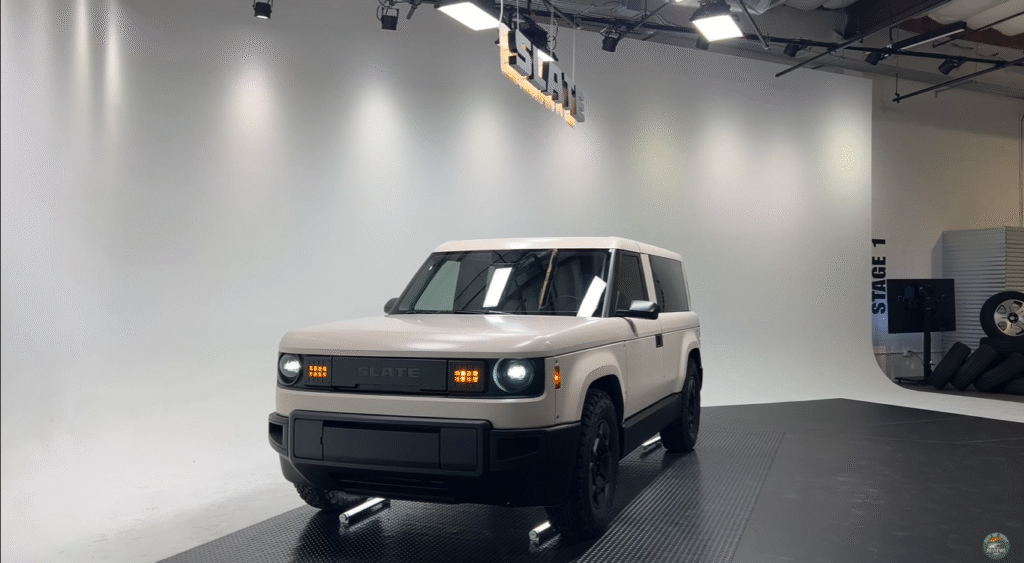
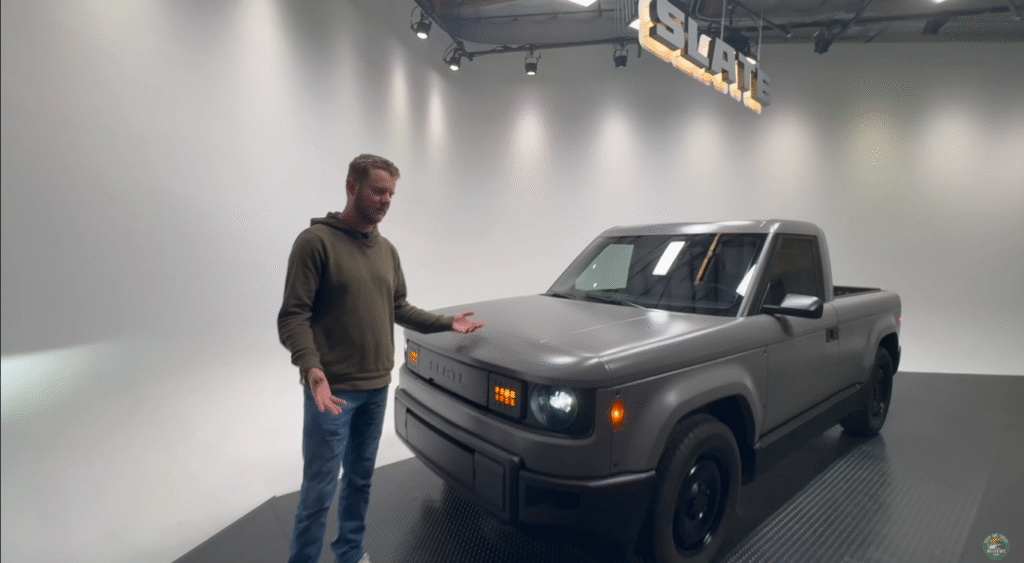
I first looked at the Slate EV prototype in Culver City, California, and explored its online configurator to see what this mini-truck offers. From its retro design to its bare-bones cabin, here’s my deep dive into the Slate EV’s design, performance, customization, practicality, drawbacks, and how it stacks up against competitors like the Ford Maverick and Chevrolet Colorado. Let’s see if this affordable EV can live up to the hype.
Design: Retro Vibes, Modern Simplicity
The Slate EV looks like it rolled out of a 1980s time capsule, with a boxy, utilitarian design that channels classics like the Chevrolet LUV or Toyota SR5. Its flat gray composite body skips traditional paint for cost savings—Slate claims this cuts manufacturing costs by $350 million—and uses dent-resistant plastic cladding to shrug off minor bumps. The 17-inch steel wheels with 245/65R17 tires keep it rugged, while alignment bolts make it easy to apply vinyl wraps (starting at $500) for a custom look, from JDM graphics to fleet branding.
At 174.6 inches long and 70.6 inches wide, it’s smaller than a Ford Maverick (199.7 inches) but bigger than a Honda Civic Hatchback. This makes it a breeze to park in tight San Francisco lots or navigate narrow trails in Colorado. The 5-foot bed (42.9 inches wide between wheel wells) handles plywood or camping gear, though it can’t fit a 4×4 post flat without angling. A 7-cubic-foot frunk with a drainage hole and cup holder inserts is perfect for tailgating or storing wet tools after a job in Miami.
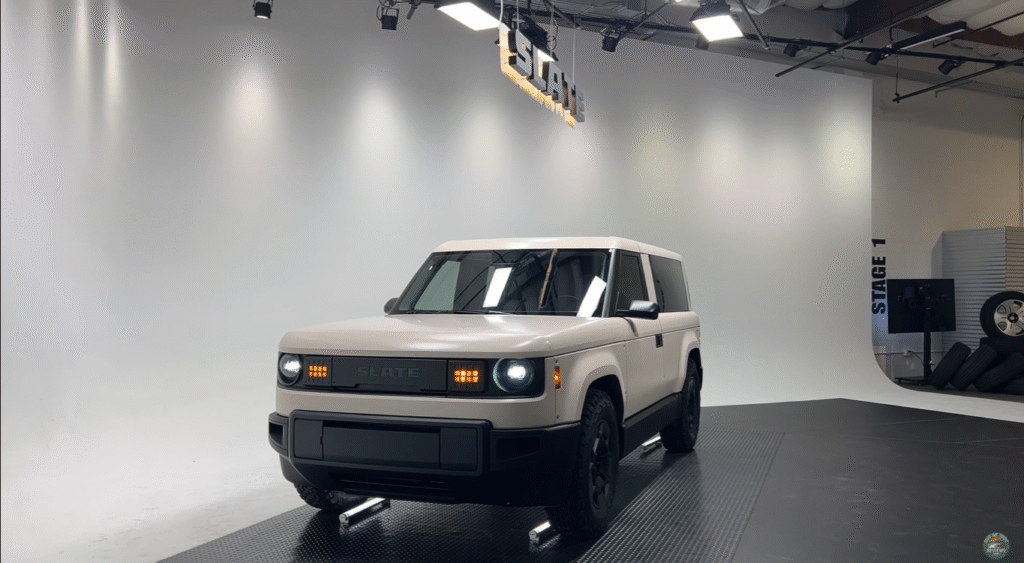
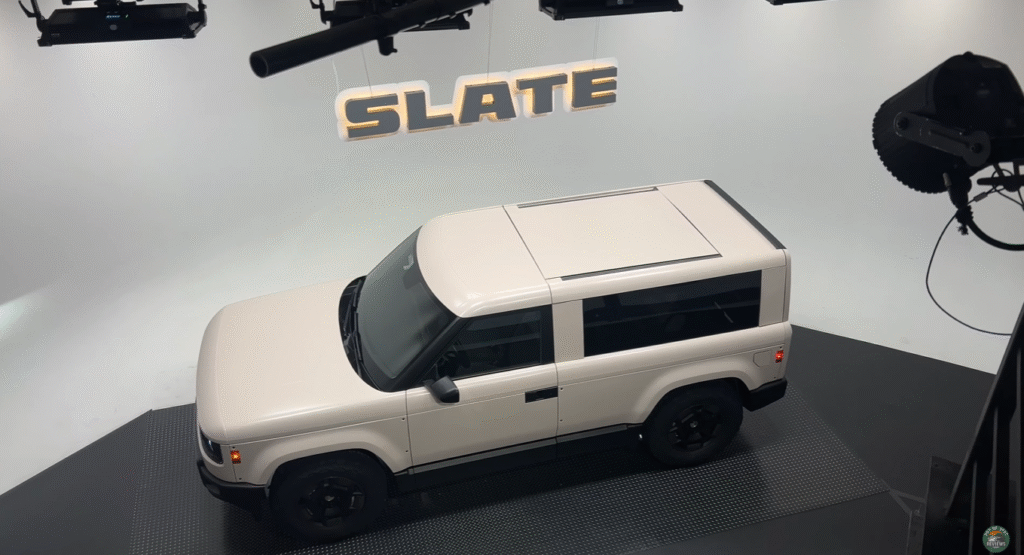

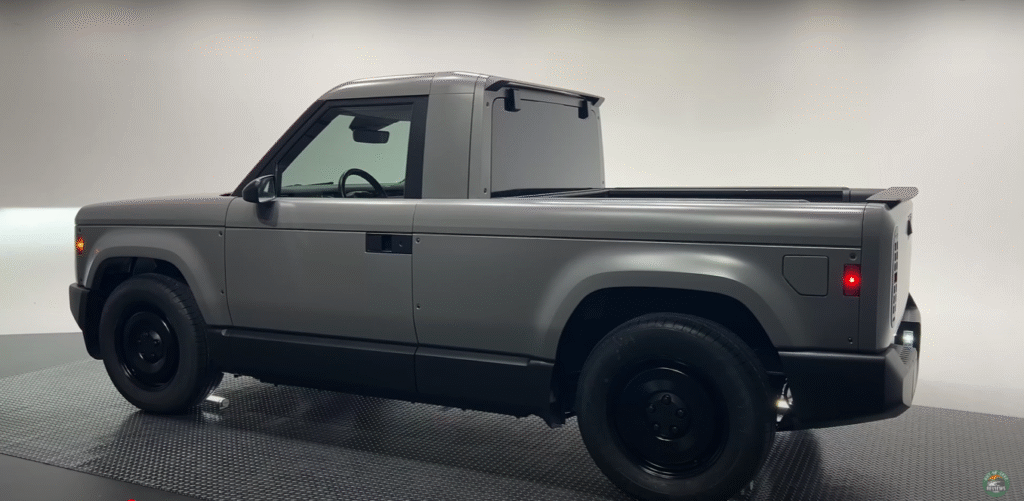
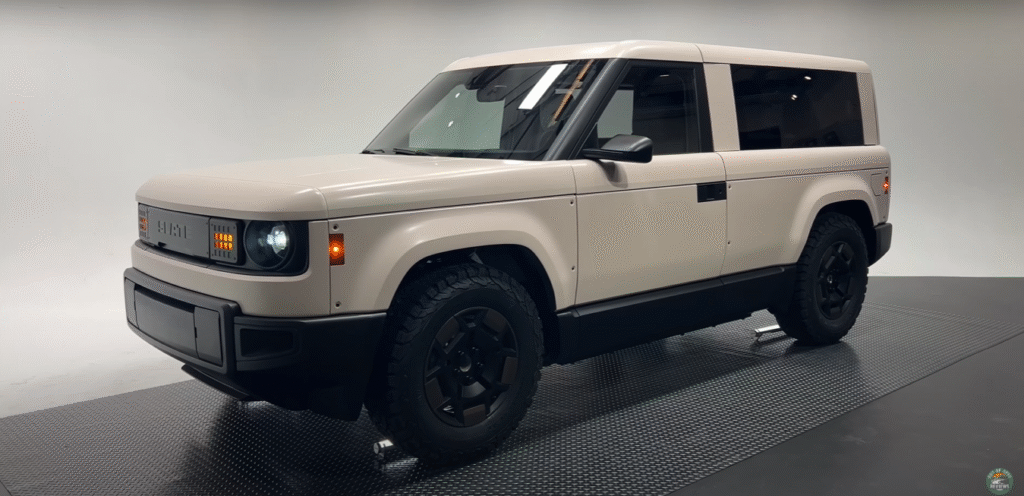
The prototype’s fit and finish felt rough—think pre-production jitters—but the manual crank windows and simple door handles add a nostalgic charm. It’s not flashy, but for buyers in Austin who want a no-nonsense truck, the Slate’s retro vibe hits the mark.
Interior: Bare-Bones but Functional
Step inside the Slate EV, and you’re greeted by a cabin that’s as minimalist as it gets. The base interior features cloth seats, HVAC knobs, and a 4-inch display for the backup camera and speedometer. There’s no infotainment screen—instead, a crash-tested phone mount with USB-C power lets you use your smartphone for navigation or music via Slate’s app. The dashboard has two storage cubbies, a plastic console, and analog climate and traction control switches. A manual parking brake and cruise control buttons are the only tech touches.
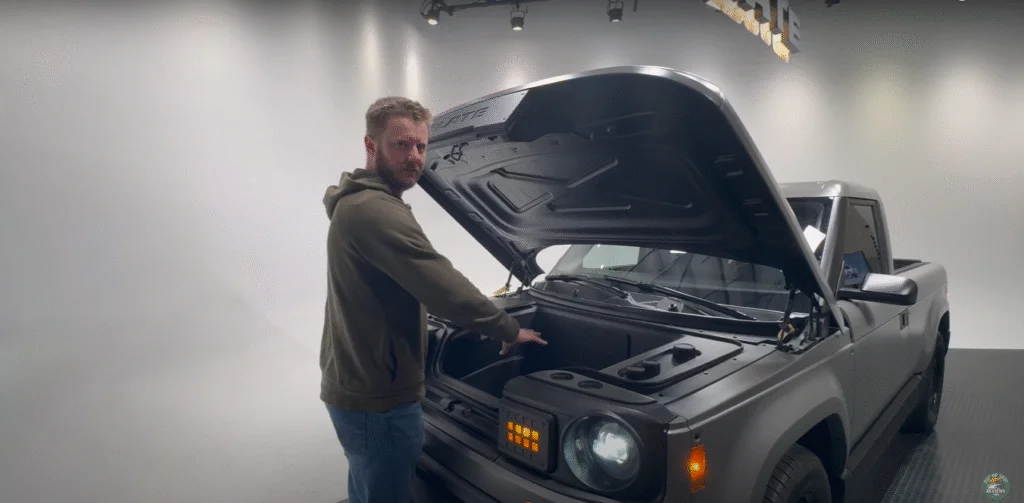
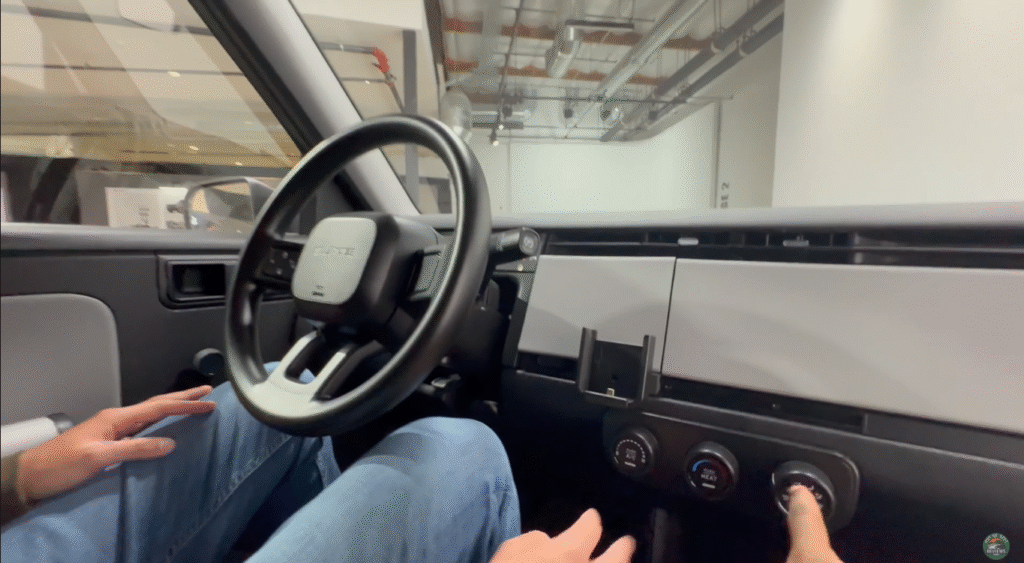
The steering wheel feels basic, but the seats are comfy for a 5’10” driver, with decent headroom. The two-seater layout keeps it simple, though an optional SUV kit adds three rear seats for kids or small adults (plus space for dogs, as shown in the prototype). You can upgrade to microfiber polyester, Alcantara, or fine-woven trim, but the base setup is built for durability, not luxury. For small business owners in Denver, this spartan cabin is practical, though it lacks the polish of a Rivian R1T’s vegan leather or the Maverick’s touchscreen.
Storage is limited to a center console and door pockets, but an optional iPad mount and auxiliary switches add functionality. The prototype’s fragile storage bins suggest Slate has work to do before production, but the focus on modularity—swappable panels and DIY upgrades—sets it apart.
Performance: Modest Power, Decent Efficiency
The Slate EV isn’t built for speed, but its single 150 kW (201 hp) electric motor on the rear axle delivers 195 lb-ft of torque, good for a 0–60 mph sprint in ~8 seconds and a 90 mph top speed. It’s peppy enough for city driving in Chicago or merging onto Atlanta highways, but don’t expect to outrun a Cybertruck. The MacPherson strut front suspension and De Dion rear suspension (inspired by the Mercedes-Benz G-Wagen) keep the ride stable, and the 3,602-pound curb weight boosts efficiency.
Two lithium-ion battery options are offered:
- 52.7 kWh: 150 miles of range (EPA estimate pending), perfect for urban commutes.
- 84.3 kWh: 240 miles of range, better for regional trips or small business runs.
The 120 kW DC fast charging via an NACS port (Tesla Supercharger-compatible) charges the smaller battery from 20% to 80% in ~30 minutes, but the larger battery takes longer, lagging behind the Cybertruck’s 250 kW. Level 2 charging (11 kW) needs ~5 hours, while Level 1 (3.6 kW) takes ~11 hours. There’s no on-route preconditioning, which could slow charging in cold Minneapolis winters. The estimated 96 MPGe (combined) is solid for a compact truck, saving ~$1,200 annually on fuel compared to a gas-powered Maverick (23 mpg).
The Slate’s 1,433-pound payload capacity matches the Maverick’s, but its 1,000-pound towing capacity falls short of the Maverick’s 1,500 pounds or the F-150 Lightning’s 10,000 pounds. It’s best for light loads like tools or bikes, not heavy trailers, making it ideal for DIYers in Seattle rather than heavy-duty contractors.
Customization: Your Truck, Your Way
What sets the Slate EV apart is its extreme customization. The online configurator offers over 100 accessories, letting you tailor the truck to your needs:
- Exterior: Off-road fenders, 31-inch Michelin tires, lowering kits, wheel spacers, roof racks, or tire carriers.
- Interior: Alcantara seats, wood trim, iPad mounts, JBL speakers, or power window kits.
- Wraps: JDM, Toyota heritage, or fleet-spec designs, with pre-cut vinyl for DIY application.
- SUV Kit: Converts the truck into a five-seater SUV (boxy or fastback) with a roll cage, airbags, and rear seats, installable in hours for ~$2,000.
Slate’s Etsy-like shop will sell consumer-designed accessories, all meeting safety standards, fostering a community-driven ecosystem. Slate University, a planned content library, will guide owners through DIY installs, from wraps to bumper swaps. For enthusiasts in Phoenix, this modularity is a dream, unlike the Rivian R1T’s fixed options. However, piling on accessories can push the price to $40,000, so budget carefully.
Practicality: Urban-Friendly, Light-Duty Workhorse
The Slate EV shines in urban environments and light-duty tasks. Its compact size makes parking a breeze in San Francisco, while the 5-foot bed and frunk handle groceries, tools, or camping gear for Oregon getaways. The 963 liters of cargo space in SUV mode (behind the second row) suits delivery drivers in Miami or families with pets. The low bed height (waist-high for a 6’1” driver) simplifies loading, and optional side rails and tie-downs secure cargo.
The base two-seater fits two comfortably, and the SUV kit adds rear seats for small passengers, with enough headroom for a 5’10” adult. The 1,433-pound payload supports landscaping or catering jobs, but the 1,000-pound towing limit restricts heavier loads. The 150-mile base range covers daily commutes (30–50 miles), while the 240-mile option handles regional trips. The NACS port ensures access to Tesla’s Supercharger network, a boon for rural Texas buyers with sparse charging options.
Safety and Tech: Basic but Safe
Slate prioritizes safety with a goal of a 5-Star NHTSA Safety Rating and IIHS Top Safety Pick. Standard features include:
- Automatic emergency braking (AEB).
- Forward collision warning.
- Up to eight airbags (with SUV kit).
- Backup camera (4-inch screen).
- ABS and traction control.
There’s no blind-spot warning, lane-keep assist, or adaptive cruise control, unlike the Maverick or Rivian R1T, reflecting Slate’s focus on driver engagement. The Slate app shows range and charger locations, and the phone mount supports navigation, but you’ll need a Bluetooth speaker for music. For minimalist drivers in Portland, this simplicity is refreshing, though tech-savvy buyers may find it lacking.
Drawbacks: Challenges to Overcome
The Slate EV has plenty of promise, but it’s not perfect:
- Short Range: The 150-mile base range pales against the Maverick Hybrid’s 500+ miles or Rivian R1T’s 400 miles, limiting long trips in rural Montana.
- Slow Charging: 120 kW DC fast charging and no preconditioning lag behind the Cybertruck’s 250 kW, especially for the larger battery.
- Low Towing: The 1,000-pound towing capacity can’t match the Maverick (1,500 pounds) or F-150 Lightning (10,000 pounds).
- Bare-Bones Features: Crank windows, no infotainment, and no ADAS may feel outdated, even at this price.
- Startup Risks: Slate’s Q4 2026 production timeline is ambitious for a new company. Recent EV startup failures (e.g., Fisker, Lordstown) raise concerns, and the prototype’s rough fitment needs polish.
- Tax Credit Uncertainty: The $7,500 EV tax credit is key to the sub-$20,000 price, but policy changes could bump costs to ~$27,500.
How It Compares: Slate EV vs. Rivals
| Feature | Slate EV Truck | Ford Maverick Hybrid | Rivian R1T | Tesla Cybertruck |
|---|---|---|---|---|
| Starting Price | ~$27,500 (~$20,000 w/ tax credit) | ~$26,000 | ~$70,000 | ~$60,000 |
| Range | 150–240 miles | 500+ miles (gas + electric) | 270–400 miles | 250–340 miles |
| Powertrain | RWD, 201 hp | FWD, 191 hp (hybrid) | AWD, 533–835 hp | AWD, 600–845 hp |
| Payload | 1,433 lbs | 1,500 lbs | 1,764 lbs | 2,500 lbs |
| Towing | 1,000 lbs | 1,500 lbs | 11,000 lbs | 11,000 lbs |
| Bed Length | 5 feet | 4.5 feet | 4.5 feet | 6 feet |
| Customization | 100+ accessories, SUV kit | Limited | Moderate | Moderate |
| Safety Features | AEB, airbags, backup camera | AEB, BSW, lane-keep assist | Full ADAS suite | Full ADAS suite |
- Ford Maverick Hybrid: Matches the Slate’s price and offers better range and towing, plus modern features like a touchscreen. The Slate’s EV powertrain and customization appeal to eco-conscious DIYers.
- Rivian R1T: A premium truck with superior range, power, and tech, but its high cost targets luxury buyers, not budget shoppers like the Slate’s audience.
- Tesla Cybertruck: Offers futuristic design, higher towing, and faster charging, but its complexity and price make the Slate a simpler, cheaper alternative.
Should You Buy the Slate EV?
The Slate EV is perfect for:
- DIY Enthusiasts: Hobbyists in Seattle or Phoenix who love modding vehicles.
- Small Business Owners: Delivery drivers or landscapers in Denver need a cheap workhorse.
- Budget EV Buyers: Urban commuters in Los Angeles seeking an affordable EV.
- Eco-Conscious Drivers: Minimalists in Portland prioritize sustainability.
It’s not ideal for:
- Long-Distance Drivers: The 150-mile range limits road trips in rural Texas.
- Heavy-Duty Users: Contractors needing high towing should choose the F-150 Lightning.
- Tech Enthusiasts: Buyers wanting ADAS or infotainment will find it too basic.
Final Verdict: A Bold Bet on Affordability
The 2025 Slate EV Pickup Truck is a breath of fresh air in the EV market, offering unmatched affordability, extreme customization, and American-made pride at ~$20,000 with tax credits. Its retro design, 5-foot bed, and SUV conversion kit make it versatile for urban commutes or light-duty work, while the 150–240-mile range and NACS charging keep it practical. However, the short range, slow charging, basic features, and startup risks mean it’s not for everyone. As a prototype, the Slate EV shows promise, but Slate Auto must refine the build quality and meet its Q4 2026 production goal to compete.
If you’re excited about a cheap, customizable EV, the $50 refundable deposit is a low-risk way to get in line. For others, waiting for production models and real-world reviews is smarter. The Slate EV could be the people’s electric truck, but it’s a gamble worth watching.
Want to learn more? Visit Slate Auto’s website to explore the configurator or reserve yours. Share your thoughts in the comments, and check out Out of Spec Reviews on YouTube for more EV insights!
Sources: Out of Spec Reviews YouTube Transcript, MotorTrend, Consumer Reports, InsideEVs, GreenCars, WIRED, TechCrunch, Top Gear, ABC News, NBC News, Driving.ca, The Fast Lane Truck, Torque News, The Drive, Motor1, The Autopian, CleanTechnica, newatlas.com, Ars Technica, USA Today, electrek.co, The Verge; X posts by @Motor1com, @itskyleconner, @Out_of_Spec, @slashgear, @TommyFaceOnFire, @The_EV_Report, @FinSavvyMike
Starts at ~$27,500 (~$20,000 with tax credits). Pre-orders open now ($50 refundable deposit), production begins Q4 2026.
Over 100 accessories, including wraps, SUV kits, tires, and interiors. Configurator and Etsy shop enable DIY personalization.
150 miles (52.7 kWh) or 240 miles (84.3 kWh). 120 kW DC fast charging, ~30 min for 20–80% on smaller battery.


One thought on “2025 Slate EV Pickup Truck Review: America’s Affordable, Customizable Electric Mini-Truck”
What’s with all the references to Portland drivers? Lots of people care about physical and ecological footprint.